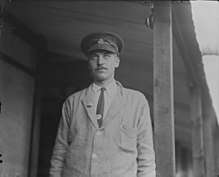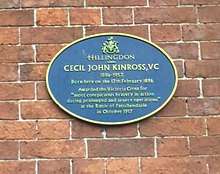Cecil John Kinross
Cecil John Kinross VC (17 February 1896 – 21 June 1957) was a Canadian soldier in World War I. Kinross was a recipient of the Victoria Cross, the highest and most prestigious award for gallantry in the face of the enemy that can be awarded to British and Commonwealth forces. He was only nineteen when it was awarded to him, making him the second youngest Victoria cross recipient ever.
Cecil John Kinross | |
|---|---|
 | |
| Born | 17 February 1896 Harefield, Middlesex, England |
| Died | 21 June 1957 (aged 61) Lougheed, Alberta, Canada |
| Buried | Lougheed Cemetery |
| Allegiance | |
| Service/ | Canadian Expeditionary Force |
| Years of service | 1915–1919 |
| Rank | Private |
| Unit | 49th (Edmonton) Battalion |
| Battles/wars | World War I |
| Awards | |
Early life
Kinross was born on 17 February 1896 at Dews Farm, Harefield, Middlesex. His father's family originated in Perthshire. He moved to Lougheed, Alberta with his parents and siblings in 1912.
Military career
Kinross was inducted voluntarily into the army at Calgary, Alberta, October 21, 1915 as a private in the 49th (Edmonton) Battalion, Canadian Expeditionary Force. On 30 October 1917, at the Battle of Passchendaele during the First World War, Kinross performed an act of bravery for which he was awarded the Victoria Cross.
No. 437793 Private Cecil John Kinross, Can. Inf.
For the most conspicuous bravery in action during prolonged and severe operations.
Shortly after the attack (on Passchendaele Ridge) was launched, the company to which he belonged came under intense artillery fire, and further advance was held up by a very severe fire from an enemy machine gun. Private Kinross, making a careful survey of the situation, deliberately divested himself of all his equipment save his rifle and bandolier and, regardless of his personal safety, advanced alone over the open ground in broad daylight, charged the enemy machine gun, killing the crew of six, and seized and destroyed the gun. His superb example and courage instilled the greatest confidence in his company, and enabled a further advance of 300 yards to be made and a highly important position to be established.[1]
Kinross was wounded in the arm and head in 1917 and hospitalised at Orpington, England. He was subsequently presented with the Victoria Cross by King George V in March 1918.

Later life
Kinross returned to Alberta after the war and was given a plot of land in Lougheed, He never married and he died at the Lougheed Hotel in Lougheed, Alberta on 21 June 1957, and is buried in the Soldier's Plot in the Lougheed Cemetery, Lougheed, Alberta, Canada.[2]
Legacy
Mount Kinross, 2560m, 24 km NW of Jasper, Alberta, in the Victoria Cross Ranges in the Jasper National Park, was named after him in 1951.
His Victoria Cross medal is held by his family while the miniature is on display at The Loyal Edmonton Regiment Military Museum in Edmonton, Alberta.
References
- "No. 30471". The London Gazette (Supplement). 8 January 1918. p. 724.
- O'Connor, Joe (9 November 2017). "They gave him a medal and named a mountain after him. But this Passchendaele veteran's story is a tragedy". National Post. Retrieved 12 December 2017.
Further reading
- Monuments to Courage (David Harvey, 1999)
- The Register of the Victoria Cross (This England, 1997)
- Scotland's Forgotten Valour (Graham Ross, 1995)
- VCs of the First World War - Passchendaele 1917 (Stephen Snelling, 1998)
External links
- Cecil John Kinross' digitized service file
- Hillingdon Council memorial plaque to Cecil Kinross, VC
- Cecil John Kinross biography on DND's Directory of Heritage and History bio
- Cecil John Kinross at Find a Grave
- Canadian Great War Project